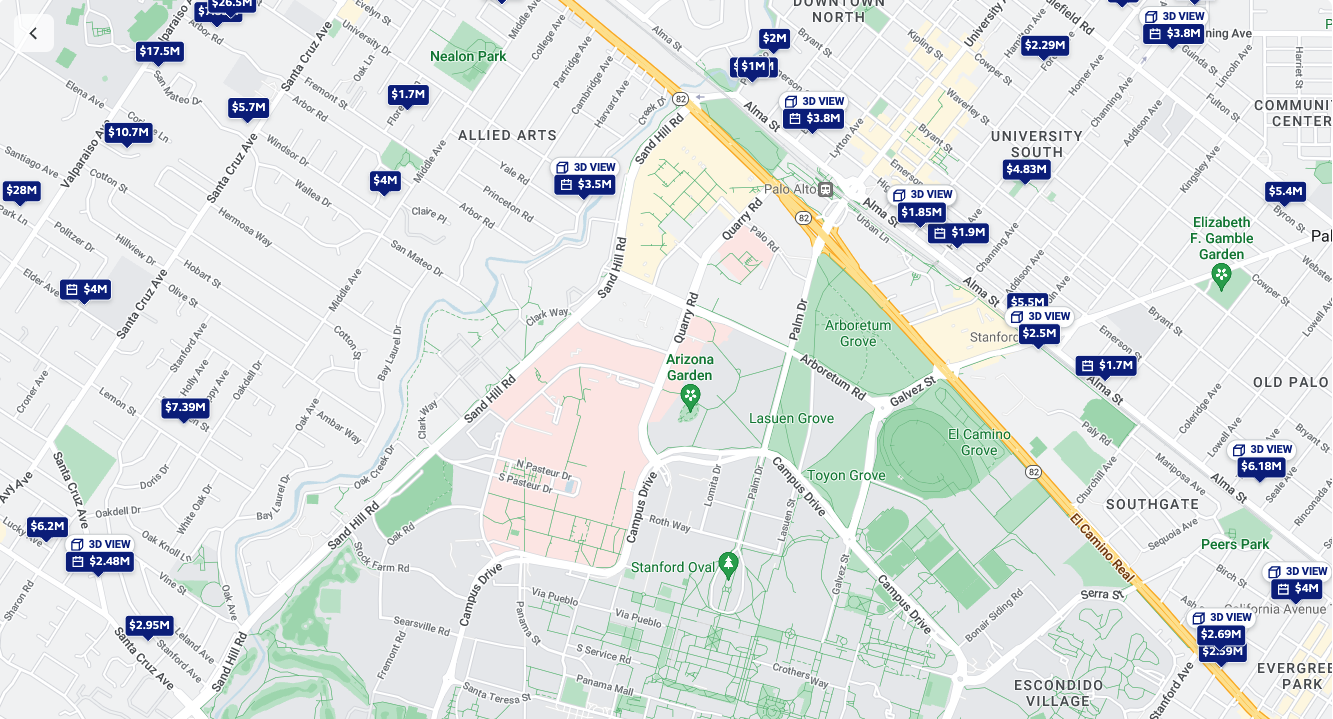Market Demand, Elasticity, and Marginal Revenue
Christopher Makler
Stanford University Department of Economics
Econ 50: Lecture 12
Today's Agenda
- Market demand
- Elasticity
- Marginal revenue
Today's Agenda
- Market demand
- Elasticity
- Marginal revenue
Section
- Doing the math on elasticity
Individual and Market Demand
Individual demand curve, \(x^*(p)\): quantity demanded by a consumer at each possible price
Market demand curve, \(D(p)\): quantity demanded by all consumers at each possible price
If there are \(N_C\) consumers in a market:
If all of those consumers are identical:
If there are \(T\) different "types" of consumers, with type \(t\) having \(N_t\) identical consumers:
Special Case: Cobb-Douglas

NOTATION AHEAD
STAY FOCUSED ON
ACTUAL ECONOMICS
Special Case: Cobb-Douglas
Suppose each consumer has the utility function
where the \(\alpha\)'s all sum to 1.
We've shown before that if consumer \(i\)'s income is \(m\), their demand for good \(k\) is
quantity demanded of good \(k\) by consumer \(i\)
consumer \(i\)'s preference weighting of good \(k\)
consumer \(i\)'s income
price of good \(k\)
There are 200 people, and they each have \(\alpha = \frac{1}{2}, m = 30\)
Suppose there are only two goods, and each consumer has the utility function
So consumer \(i\) will spend fraction \(\alpha_i\) of their income \(m_i\) on good 1:
Market demand:
number of consumers
quantity demanded by each consumer
Note: total income is \(200 \times 30 = 6000\), so this means the demand is the same "as if" there were one "representative agent" with \(\alpha = \frac{1}{2}, m = 6000\)
Individual demand:
Now suppose there are two types of consumers:
Again there are only two goods, and each consumer has the utility function
100 low-income consumers who don't like this good: \(\alpha_L = \frac{1}{4}, m_L = 20\)
100 high-income consumers who do like this good:\(\alpha_H = \frac{3}{4}, m_H = 40\)
(demand from
low-income)
(demand from
high-income)
Market demand:
Individual demand:
Note: total income is \(100 \times 20 + 100 \times 40 = 6000\), so this means the demand is the same "as if" there were one "representative agent" with \(\alpha = \frac{7}{12}, m = 6000\)
Conundrum
In both cases, average income was 30 and average preference parameter \(\alpha\) was \(\frac{1}{2}\).
When everyone was identical, it was "as if"
there was a representative agent with all the money
with preference parameter \(\alpha = \frac{1}{2}\).
When rich people had a higher \(\alpha\), it was "as if"
there was a representative agent with all the money
with preference parameter \(\alpha = \frac{7}{12} > \frac{1}{2}\).
How Demand Aggregates Preferences
Feel free to tune out the intermediate steps, but hang on to the econ...
How market demand aggregates preferences
If consumer \(i\)'s demand for good \(k\) is
then the market demand for good \(k\) is
where \(M = \sum m_i\) is the total income of all consumers
and \(\alpha_k\) is an "aggregate preference" parameter.
Conclusion: we can model demand from \(N_C\) consumers with Cobb-Douglas preferences
"as if" they were a single consumer with "average" Cobb-Douglas preferences.
so what is \(\alpha_K\)?
If everyone has the same income (\(m_i = \overline m\) for all \(i\)), then demand simply aggregates preferences:
Let \( \overline m = M/N_C\) be the average income. Then we can rewrite market demand as:
\(\alpha_K\)
But if there is income inequality, \(\alpha_k\) gives more weight to the prefs of those with higher income.
\(=1\)
Example: consider an economy in which rich consumers like a good more:
100 low-income people with \(\alpha_L = \frac{1}{4}, m_L = 20\),
100 high-income people with \(\alpha_H = \frac{3}{4}, m_H = 40\)
Average income is \(\overline m = 30\), total income is \(M = 6000\)
So, market demand is
closer to \(\alpha_H\) than \(\alpha_L\)
Example, revisited
Source: trulia.com, 5/12/22

Conclusion: Aggregating Preferences
You can model market demand as reflecting the preferences of a single representative agent.
But...know that you're weighting the preferences of richer people more.
Elasticity
Why Elasticity?


Own-Price Elasticity
What is the effect of a 1% change
in the price of good 1 \((p_1)\) on the quantity demanded of good 1 \((x_1^*)\)?
no change
perfectly inelastic
less than 1%
inelastic
exactly 1%
unit elastic
more than 1%
elastic
-
How does \(x_1^*\) change with \(p_1\)?
- Own-price elasticity
- Elastic vs. inelastic
Three Relationships
Cross-Price Elasticity
What is the effect of an increase
in the price of good 2 \((p_2)\) on the quantity demanded of good 1 \((x_1^*)\)?
no change
independent
decrease
complements
increase
substitutes
-
How does \(x_1^*\) change with \(p_1\)?
- Own-price elasticity
- Elastic vs. inelastic
-
How does \(x_1^*\) change with \(p_2\)?
- Cross-price elasticity
- Complements vs. substitutes
Three Relationships
Income Elasticity
What is the effect of an increase
in income \((m)\) on the quantity demanded of good 1 \((x_1^*)\)?
decrease
good 1 is inferior
increase
good 1 is normal
-
How does \(x_1^*\) change with \(p_1\)?
- Own-price elasticity
- Elastic vs. inelastic
-
How does \(x_1^*\) change with \(p_2\)?
- Cross-price elasticity
- Complements vs. substitutes
-
How does \(x_1^*\) change with \(m\)?
- Income elasticity
- Normal vs. inferior goods
Three Relationships
Demand Elasticity: \(\epsilon = \frac{\%\Delta Q}{\%\Delta P}\)
[poll question...]
Calculating Elasticities in General
Demand Elasticity:
\(\epsilon_{q,p} = \frac{\%\Delta q}{\%\Delta p}\)
Revenue
Demand and Inverse Demand
Demand curve:
quantity as a function of price
Inverse demand curve:
price as a function of quantity
QUANTITY
PRICE
Demand
Inverse Demand
If the firm wants to sell \(q\) units, it sells all units at the same price \(p(q)\)
Since all units are sold for \(p\), the average revenue per unit is just \(p\).
By the product rule...
let's delve into this...
Total, Average, and Marginal Revenue
Demand
Inverse Demand
Revenue
[poll question...]
The total revenue is the price times quantity (area of the rectangle)
Note: \(MR < 0\) if
The total revenue is the price times quantity (area of the rectangle)
If the firm wants to sell \(dq\) more units, it needs to drop its price by \(dp\)
Revenue loss from lower price on existing sales of \(q\): \(dp \times q\)
Revenue gain from additional sales at \(p\): \(dq \times p\)
Marginal Revenue and Elasticity
(multiply first term by \(p/p\))
(simplify)
(since \(\epsilon < 0\))
Notes
Elastic demand: \(MR > 0\)
Inelastic demand: \(MR < 0\)
In general: the more elastic demand is, the less one needs to lower ones price to sell more goods, so the closer \(MR\) is to \(p\).
Marginal Revenue for Perfectly Elastic Demand
(multiply first term by \(p/p\))
(simplify)
(since \(\epsilon < 0\))
Note
Perfectly elastic demand: \(MR = p\)
Econ 50 | Spring 2022 | 12 | Market Demand
By Chris Makler
Econ 50 | Spring 2022 | 12 | Market Demand
- 521



